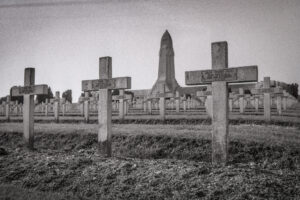Le Clos du Pausa, Thillombois, 29th March 1999
We drove east from Thillombois to Bouquemont in fog and followed the Meuse north towards Verdun. The river was still and grey, patterned with the ghostly reflections of skeletal trees. Each rise in the road brought us a little closer to the sun and the fog thinned into a luminous mist. Above Verdun we climbed a hairpin bend into bright sunlight that vitalised the vibrant emerald roadside mosses and sparkling white silver birches – brimstones flitted among cowslips and violets.
By the Maginot Memorial (André Maginot (1877-1932), principal advocate of the eponymous line) only the calling of robins, chiffchaffs and the occasional drumming of a woodpecker broke the respectful silence. Ultramarine anemones studded the edge of the woods and green swathed craters marked the shell bursts of 80 years ago. A crow rasped out a warning from the pines; and we saw the ashy tower of the Ossuary in the distance – it is said to be designed in the outline of an artillery shell, but to modern eyes it is suspiciously phallic.
The Battle of Verdun lasted for 10 months (21 February 1916 – 19 December 1916) and took the lives of 230,000 men out of a total of 700,000 casualties. The battle became known in German as Die Hölle von Verdun and in French as L’Enfer de Verdun. The intense fighting was conducted on a battlefield covering less than eight square miles.
The Douaumont Ossuary contains the remains of both French and German soldiers, who died in the battle. The skeletal remains of at least 130,000 unidentified combatants fill up alcoves at the lower edge of the building. Inside the barrel-vaulted ceiling and walls of the cloister, barely illuminated by light filtering through orange windows, are covered by plaques bearing names of the French dead. The biggest French military cemetery of the First World War – 16,142 graves – marches down the hill in mournful ranks from the front of the monument. A squad of American soldiers in fatigues passed us on the steps. Plus ca change.
We left the ranks of grey crosses and drove on to Fort Douaumont, the largest of the ring of 19 large defensive works, which had secured the city of Verdun since the 1890s. By 1915, the French General Staff had concluded that even the best-protected forts could not withstand bombardments from the German super-heavy howitzers and had been partly disarmed and left virtually undefended. On 25 February 1916, Fort Douaumont was taken without a fight by a small German raiding party of 95 officers and men. Its fall set the stage for the rest of a battle. Douaumont was finally recaptured by three infantry divisions in October 1916.

